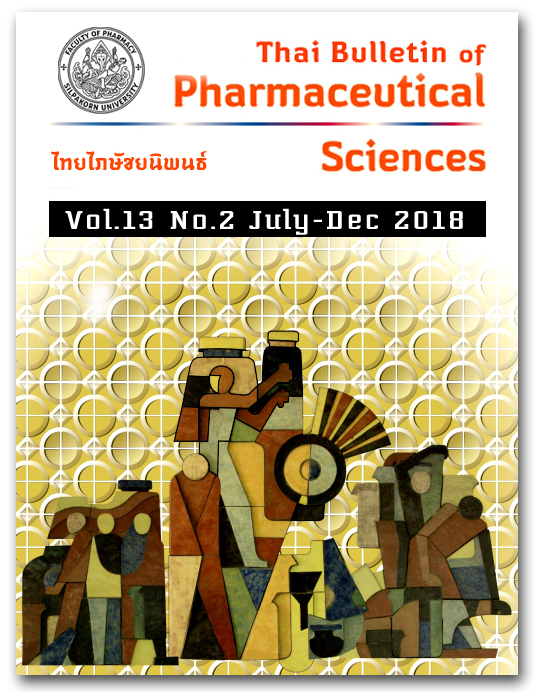NUTRITIONAL KNOWLEDGE FOCUSING ON WEIGHT CONTROL AMONG OFFICE PERSONNEL: A CASE STUDY OF ACADEMIC SUPPORT STAFF AT FACULTY OF SCIENCE AND FACULTY OF EDUCATION, SILPAKORN UNIVERSITY
DOI:
https://doi.org/10.69598/tbps.13.2.69-85Keywords:
nutritional knowledge, weight control, weight reduction, overweight, obesityAbstract
Being overweight and obese leads to non-communicable diseases and can affect quality of life. This study aimed to survey the nutritional knowledge, focusing on weight control, among academic support staff at the Faculty of Science and the Faculty of Education, Silpakorn University. There were 110 participants: 69 from the former faculty and 41 from the latter. The mean (SD) age was 42.3 (9.3) years. The majority of the participants (65.5%) had earned a bachelor degree or higher. This study revealed that, among the participants, 67.3% were overweight or obese, 50.9% were centrally obese, and 40% were undergoing weight reduction. The participants self-completed a questionnaire on nutritional knowledge related to weight control which consisted of 20 items. The median (IQR) of the knowledge score was 10.5 (3). Their nutritional knowledge was associated with their education level (p = 0.041) and gender (p = 0.034). Based on the large number of incorrect answers, the three most important nutritional aspects that should be addressed were the nutritive value of pumpkins (79.1%), mung beans (69.1%) and peanuts (65.5%). Another issue that should be rectified based on scientific evidence was “cold-pressed coconut oil and weight reduction”, which 63.6% replied incorrectly. Most participants (38.2%) indicated that social media was the most appropriate channel for providing health care information; therefore nutritional education about weight control by health professionals through this media appeared to be beneficial for office personnel.
References
2. Aekplakorn W. Health status. In: Aekplakorn W, editor. Thai National Health Examination Survey, NHES V. Nonthabri: Healthy system research institute, 2014; p. 134. (in Thai)
3. World Health Organization. Noncommunicable diseases country profiles 2014 [Online]. 2014 [cited 2018 Jan 5]; Available from: URL: http://www.who.int/nmh/countries/en/
4. Sheehan AM, Chen JT, Yanovski JA, Calis KA. Obesity. In: Dipiro JT, editors: Pharmacotherapy: a pathophysiologic approach 10th eds. New York: McGraw-Hill Education; 2017; p.2385-402.
5. Garvey WT, Mechanic JI, Brett EM, Garber AJ, Hurley DL, Jastreboff AM, et al. American association of clinical endocrinologists and American college of endocrinology comprehensive clinical practice guidelines for medical care of patients obesity. Endocr Pract. 2016 ;22(suppl 3)
6. Pitayatienanan P, Butchon R, Yothasamut J, Aekplakorn W, Teerawattananon Y, Suksomboon N, et al. Impact of overweight and obesity on health-care costs in Thailand. J Health Syst Res. 2011;5(3):287-98 (in Thai)
7. Boonchayaanant P, Vorasettakarnkij Y, editors. Guideline for overweight and obesity. Bangkok: Network of Fatless Belly Thais. The Royal College of Physician of Thailand; 2015. (in Thai)
8. Paopeng C, Pongutta S, Limwattananon S, Limwattananon C, Chaiyasong S, Tisayaticom K, et al. Food consumption behaviors among different groups of thai population: do demographic, socio-economic, and health status matter? J Health Syst Res. 2011;11(3):287-98. (in Thai)
9. Robert CW. Body mass index as an indicator of obesity. Asia Pacific J Clin Nutr. 2002;11(Suppl):S681–4.
10. Institute of medical research and technology assessment. Clinical practice guideline for management, prevention and treatment of obesity. Nonthaburi; 2010 (in Thai)
11. Sommasut R. Thai food exchange list. Thai JPEN. 2004;15(1):33-45. (in Thai)
12. Research project of nutritional counseling for prevention risk of secondary stroke, Institute of Nutrition Mahidol University. Food exchange lists. [cited 2017 Dec 25] (in Thai); Available from: http://resource.thaihealth.or.th/ library/hot/13411
13. Bureau of Nutrition. Metabolic syndromes. [cited 2015 Jan 10] (in Thai); Available from: http://nutrition.anamai. moph.go.th/images/files/metabolic_syndrome.pdf
14. Institute of Nutrition, Mahidol University. Thai food composition tables 1st eds. Nakhon Pathom; Institute of Nutrition, Mahidol University; 1999.
15. Tepdecha C, Pongsupan J, Leelapattanapanith M, Kaomek M. Knowledge and vegetable consumption of academic supporting staff at Faculty of Pharmacy, Silpakorn University [unpublished research senior project]. Nakhon Pathom: Silpakorn University, 2014. (in Thai)
16. National Institutes of Health National Heart, Lung, and Blood Institute. Third report of the national cholesterol education program (NCEP) expert panel on detection, evaluation, and treatment of high blood cholesterol in adults (Adult Treatment Panel III). [cited 2005 Jan 10]; Available from: https://www.nhlbi.nih.gov/files/docs/ resources/heart/atp-3-cholesterol-full-report.pdf
17. Krishna G, Raj G, Singh BA, Kumar P, Chandrashekar P, Coconut oil: chemistry, production and its applications- a review. Indian Coconut J. 2010;53(3):15-27.
18. Assunção ML, Ferreira HS, dos Santos AF, Cabral CR Jr, Florêncio TM. Effects of dietary coconut oil on the biochemical and anthropometric profiles of women presenting abdominal obesity. Lipids. 2009;44(7):593-601.
19. Eyres L, Eyres MF, Chisholm A, Brown RC. Coconut oil consumption and cardiovascular risk factors in humans. Nutr Rev. 2016;74(4):267-80.
20. Nelms NM, Sucher KP, Long S, editors. Nutrition therapy and pathophysiology. Belmont, CA: Thomson Brooks/Cole; 2007; p. 152-3, 481.
21. Liau KM, Lee YY, Chen CK, Rasool AG. An open-label pilot study to assess the efficacy and safety of virgin coconut oil in reducing visceral adiposity. ISRN Pharmacology 2011, Available from: http://dx.doi.org/ 10.5402/2011/949686
22. Bureau of Nutrition. Edible oil. [cited 2013 Oct 23] (in Thai); Available from: http://www.moph.go.th/ops/iprg /news_pic/บทความเรื่องน้ำมันบริโภค
23. Naidoo J, Willis J. Foundation for health promotion 3rd eds. Edinburgh: Bailliere Tindall/Elsevier; 2009; p.67-83
24. Institute for Population and Social Research, Mahidol University. Thai health report 2016. Nakhon Pathom: Institute for Population and Social Research, Mahidol University; 2016. (in Thai)
Downloads
Published
How to Cite
Issue
Section
License
All articles published and information contained in this journal such as text, graphics, logos and images is copyrighted by and proprietary to the Thai Bulletin of Pharmaceutical Sciences, and may not be reproduced in whole or in part by persons, organizations, or corporations other than the Thai Bulletin of Pharmaceutical Sciences and the authors without prior written permission.



